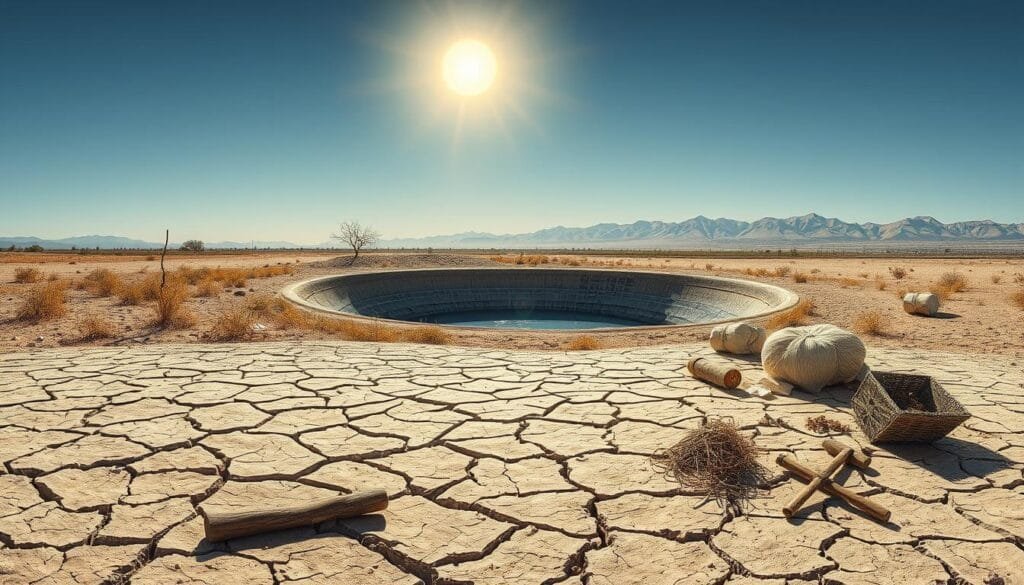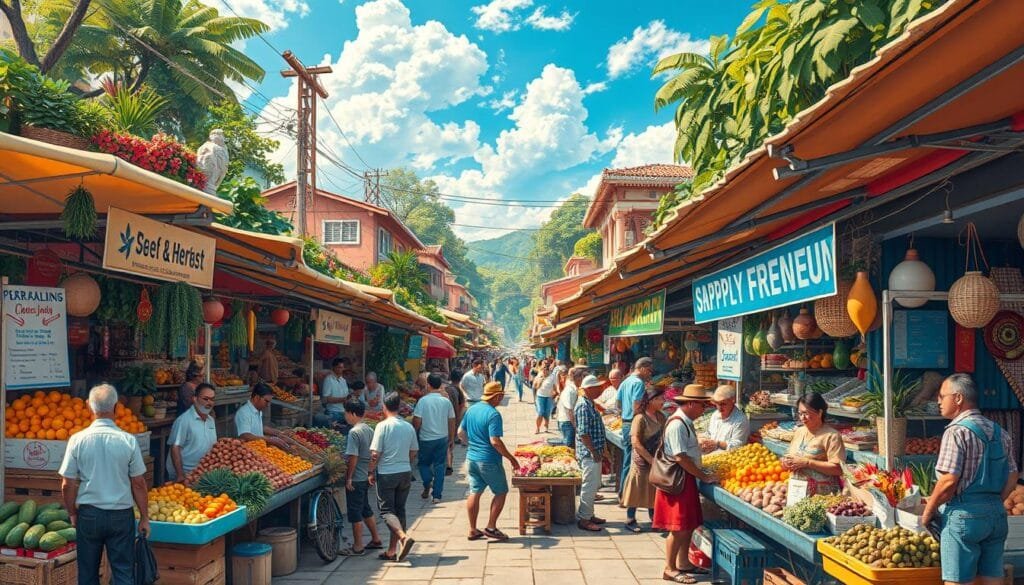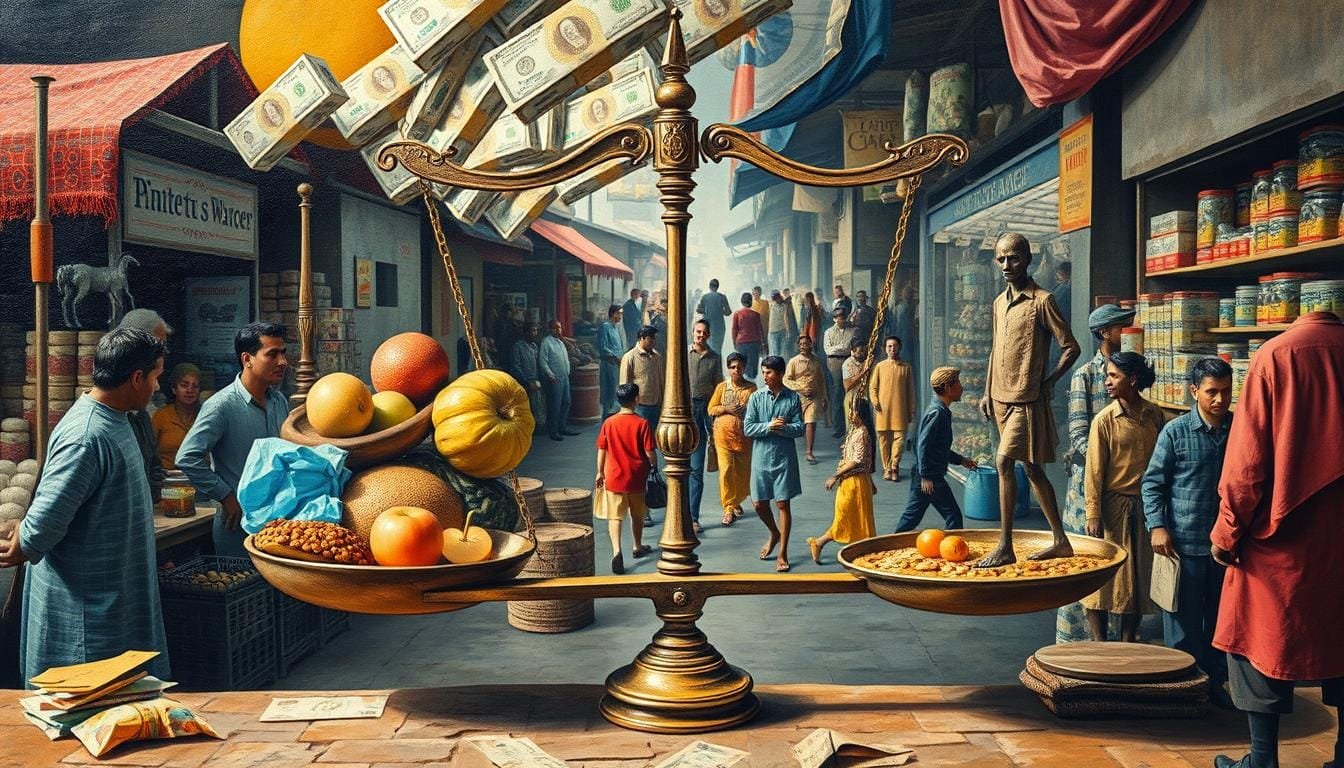Have you ever seen prices skyrocket for items that were cheap before? This happens because of scarcity. It’s a key economic problem. Our world has limited resources but unlimited desires. This mismatch is at the heart of many economic challenges we face daily.
Scarcity makes us decide how to use our resources. Should healthcare get more attention than movies? Is it better to invest in clean energy or the armed forces? Each choice means giving something else up. That’s called opportunity cost. Grasping scarcity helps us make smarter choices, showing us the real impact of our decisions.
Things like a drop in wheat supply can make prices jump. Or a lack of workers can hit industries hard, like transport and health. For example, we could see a shortage of 18 million healthcare workers by 2030. That’s a big issue. Scarcity affects prices too. In luxury goods, being rare can make something more valuable.
Key Takeaways
- Scarcity arises due to the mismatch between limited resources and unlimited wants.
- It necessitates making economic decisions involving opportunity costs.
- The scarcity principle indicates that high demand and low supply drive prices up.
- Real-world examples include labor shortages in healthcare and seasonal product shortages.
- Understanding scarcity is crucial for effective resource allocation and policy-making.
What is Scarcity in Economics?
Scarcity is key in economics. It affects how we decide on using our resources. It shows the gap between limited resources and people’s endless wants.
Definition of Scarcity
Scarcity means we have limited resources but unlimited wants. This problem makes everyone, from single people to governments, decide how to use these resources. We must think about what we give up when we pick one choice over another. This idea brings in the concept of opportunity cost. For instance, when strawberries are scarce due to low shipments, it leads to shortages.
Importance of Scarcity in Economics
Scarcity’s role in economics is crucial as it shapes how we make choices. It pushes us to set priorities and use resources well. Take the Malthusian trap as an example. It shows how more food can lead to more people, but then things might go back to how they were. This shows how scarcity affects both now and the future.
This idea points out why we need smart economic choices in our lives and in policy making. By understanding scarcity, we can manage complex choices better and aim for sustainable use of resources.
Examples of Scarcity in the Real World
Scarcity means we have limited resources to meet endless wants. It shows up in different areas around the world. By looking at examples of scarcity, we understand its impact and the hard choices it creates.
Land Scarcity
Land is becoming scarce, especially where industries are growing fast. Urban growth, cutting down forests, and lands turning to desert are big reasons. In Sub-Saharan Africa, desert lands are growing, hurting farm production.
Water Scarcity
Water scarcity is a growing problem, made worse by climate change. In the Middle East and parts of India, water is running low. This lack of water hurts farming, businesses, and everyday life.
Labor Shortages
Labor shortages happen when workers’ skills don’t match job needs. In the UK, there’s a big need for workers in health and farm jobs. This shows how policy and changes in population can make shortages worse.
Healthcare Shortages
Not having enough healthcare is a clear example of scarcity. This shows up as too few resources, long waits, and hard-to-reach essential medical care. Japan’s aging population puts a lot of pressure on its healthcare.
Seasonal Shortages
Seasonal shortages make certain goods hard to find at times of the year. Things like holiday gifts and seasonal drinks from Starbucks get scarce when everyone wants them at the same time.
Fixed Supply of Roads
In cities, there are only so many roads, but more and more cars. This causes traffic jams and inefficient travel. It shows why cities need to plan better and invest in public transport.
Scarcity challenges us in many parts of our daily lives. It shows why planning well and using resources wisely is crucial to solve these problems.
Causes of Scarcity
To really grasp economic ups and downs, it’s key to know why scarcity happens. We can pin the blame on three big reasons: too much demand, not enough supply, and sometimes, both playing at the same time. These elements mess with how much stuff is out there for us to use, leading to big headaches for economies everywhere.
Demand-Induced Scarcity
When everyone wants more of something than there is available, demand-induced scarcity steps in. This is super common in places with lots of people growing fast. They all need basics like water, food, and a place to live, but there’s just not enough to go around. Think about how everyone seems to want the latest phone or the trendiest clothes, and suddenly, there’s not enough to meet the demand.

Supply-Induced Scarcity
Supply-induced scarcity hits when there’s a hitch in making or getting products to stores. Bad weather wrecking crops or running out of natural resources can cut supplies short. This kind of scarcity throws markets into chaos. They struggle to get what people want into their hands.
Combination of Both
Oftentimes, scarcity comes from both demand shooting up and supply dwindling. Take the U.S. labor market as an example. Back in 2016, over 158 million folks were working away. Yet, finding the right skills was a tough one due to not enough training or education. This mix-up leads to tricky economic imbalances that make it hard for decision-makers to balance things out.
| Type of Scarcity | Description | Impact Example |
|---|---|---|
| Demand-Induced Scarcity | High demand outpaces current supply | Consumer electronics shortages |
| Supply-Induced Scarcity | Supply chain or production limitations | Agricultural failures |
| Combination of Both | Factors of both high demand and limited supply | Skilled labor shortages |
Wrapping up, spotting the different causes of scarcity is crucial for fighting its effects and keeping our economy steady. Both skyrocketing demand and stumbling supply spark economic imbalances. They mess with prices and how much stuff is out there for us across various sectors.
How the Free Market Solves Scarcity
The free market tackles scarcity with economic rewards and price changes. These strategies help allocate resources well and control demand. Let’s explore how these methods reduce scarcity.

Price Mechanism
Prices play a key role in the free market. If something gets rare, its price goes up. This jump in price tells people to use less and encourages makers to create more. For instance, the world saw a chip shortage in 2020. Prices shot up. Big car companies like Ford and General Motors had to change their production plans.
Incentives for Alternatives
Higher prices push both buyers and sellers to act. Sellers look for new resources or tech. A good example is the hunt for helium substitutes. It shows how the free market moves to beat scarcity.
Long-term Demand Adjustments
Over time, people change how they use resources because of price and availability shifts. The pandemic taught us this. People stocked up on things like hand sanitizers at first. But, as things became normal, people bought less. We see this with water in dry areas, where droughts cause big changes in how water is used.
| Event | Impact of Scarcity | Market Response |
|---|---|---|
| 2020 Semiconductor Shortage | Increased prices, disrupted production | Surge in investment for alternatives |
| 2020-2021 Pandemic Supply Disruptions | Scarcity of essentials, price hikes | Behavioral adjustments, stockpiling |
| Prolonged Droughts | Water scarcity, increased cost | Adoption of water-saving technologies, usage adjustments |
The Scarcity Principle and Market Equilibrium
The scarcity principle is key to market equilibrium. It shows how supply and demand interact. Limited resources prompt markets to adjust and behave in certain ways.

Dynamic Between Supply and Demand
Supply and demand shape market operations. If a product is rare but wanted more, prices can increase. For example, in 2016, the U.S. had over 158 million workers. Still, some industries had not enough workers, leading to better wages and perks to attract more employees.
Impact on Prices
Scarcity makes products more expensive and creates a new balance in the market. The real estate sector shows this, where limits on space and finance influence buying houses. Fewer houses plus more buyers equal higher prices. Colleges also see this effect. Limits on time and teacher availability affect class choices, pushing up costs.
Disequilibrium and Market Adjustments
Sometimes, demand outpaces supply, causing market shifts. Limited-time sales use scarcity to encourage buying. Brands like Supreme drop rare products to increase desire. These moves lead to more production or new options, helping markets find balance again.
| Factor | Example | Impact |
|---|---|---|
| Limited Workforce | 2016 US Labor Force | Higher Wages |
| Geographical Constraints | Real Estate Markets | Increased Property Prices |
| Exclusive Products | Supreme Limited Editions | Enhanced Demand & Urgency |
Grasping supply-demand dynamics helps understand market moves due to scarcity. It shows why prices change, moving markets toward balance.
Scarcity and Market Failure
Scarcity can lead to market failure by not distributing resources well. This often results in less than ideal economic situations. People tend to look out for themselves, ignoring wider impacts. The Corporate Finance Institute explains that externalities, public goods, market control, and imperfect info drive these failures. Knowing about these can help create laws and pricing strategies to fix inefficiencies.
Potential Market Failures Due to Scarcity
Scarcity can make market failure worse in several ways:
- Negative externalities, such as pollution, harm communities by damaging health and the environment.
- Information failures can cause people to pay too much for houses due to missing market details.
- Monopolies and oligopolies disrupt normal pricing. Research shows prices can increase by 20-50% in such markets.
- Public goods like national defense and education often get too little production, needing government help.
Inequity and Inequality
Scarcity often makes economic inequality worse. This leaves poorer communities struggling for essential resources. This struggle increases poverty and makes it hard for people to improve their lives. The Gini index, which measures income inequality, shows significant gaps in many rich countries. This fact stresses the importance of inequity. Steps like subsidies or taxes that redistribute wealth can be crucial in reducing economic inequality.
Environmental Resource Scarcity
Environmental scarcity challenges sustainable growth and fair resource use. Overexploiting resources like water, land, and minerals causes lasting damage. As these resources dwindle, deciding who gets what becomes harder, often leading to skewed markets. Strategies like quotas or rationing are sometimes used, yet they might cause problems like black markets. We need sustainable methods and laws to solve these issues.
| Market Failure Type | Example | Potential Remedy |
|---|---|---|
| Negative Externalities | Pollution in Manufacturing | Imposing Environmental Taxes |
| Information Failures | Real Estate Price Discrepancies | Public Information Campaigns |
| Monopolies | High Prices in Pharmaceuticals | Antitrust Laws |
| Public Goods Underproduction | Lack of Public Education | Government Provision/Subsidies |
What is Scarcity in Economics Easy Definition
Economics is all about scarcity. This is where people have more wants than available resources. Understanding scarcity helps us see why we must make choices. It forces us to decide how best to use our resources, considering the opportunity costs.
Consider the worker-to-manager ratio of 4:1, with 20,000 workers to 5,000 managers. This means we need 20 workers for every manager. Such a gap shows how we have to wisely use what we have to meet our goals effectively.
Patents in the drug market create a type of scarcity. They protect new drugs for up to 20 years. This allows inventors to profit. At the same time, the Federal Reserve fights inflation. It does this by controlling the money out there, raising interest rates, and requiring banks to keep more money in reserve.
Scarcity also hits our natural resources, which are limited. Managing these resources right is key. In places like Southern California, water is often scarce. This issue highlights how important it is to allocate our resources wisely. Government regulations on pollution show how scarcity changes market prices. They force companies to clean up their act, affecting everyone’s wallets.
The Malthusian theory ties into this. It suggests a clash between growing populations and food production rates. Thomas Malthus pointed out that while people can increase rapidly, resource growth is much slower. This theory underlines the crucial debate on how to use our resources sustainably.
| Concept | Examples | Impact |
|---|---|---|
| Labor Scarcity | 4:1 worker-to-manager ratio | Efficiency in production |
| Patent Scarcity | 20-year patent exclusivity | Incentivizes innovation |
| Natural Resource Scarcity | Water crises in Southern California | Necessitates resource management |
| Environmental Regulations | Pollution control investments | Shifts economic burden to market prices |
| Malthusian Theory | Food vs. population growth | Global hunger and sustainability |
This table explains different scarcity forms and their effects. Whether it’s managing workers, protecting inventions, or solving environmental challenges, scarcity requires us to plan carefully and prioritize to make the most of our resources.
Conclusion
In the world of economics, the idea of scarcity is key. It explains how we decide to use what we don’t have enough of. Our knowledge of scarcity shows us why we make certain choices. It lets us see their effects in our everyday life. Understanding scarcity helps us grasp why things are valuable and how prices change.
Looking back, T. R. Malthus talked about how people grow faster than the food we can make. Today, water shortages in Southern California remind us that scarcity still matters. Scarcity takes many forms, from hard-to-get titanium to diamond mining. Even hurricanes like Fran show us how scarcity changes prices and affects us all.
As future challenges come, scarcity teaches us how to plan and use what we have wisely. It makes us think about big and small economic decisions. Knowing about scarcity guides us to make smart choices. This deep insight helps us deal with our world’s economic changes in smart ways.
FAQ
What is scarcity in economics?
Scarcity in economics means we have limited resources but unlimited wants and needs. This situation forces us to make choices on how to allocate these resources. Such choices come with opportunity costs. Scarcity makes us make wise decisions and affects how resources are shared, both personally and in policy.
Why is scarcity important in economics?
Scarcity is key in economics because it makes us decide what and how to produce and for whom. It’s the backbone of economic theory, highlighting the importance of managing resources wisely. This ensures we meet the most important needs and wants of society.
Can you provide an example of scarcity in the real world?
Water scarcity is a clear real-world example. Global warming has made some regions drier, decreasing water supply. This situation shows the importance of managing and allocating water efficiently.
What causes scarcity?
Scarcity happens when demand is higher than supply, like with popular consumer goods. It can also happen when there is less production, such as during crop failures. It usually results from a mix of both demand and supply issues.
How does the free market solve scarcity?
The free market solves scarcity through price signals. When prices go up, people buy less and producers look for new solutions or technology. This helps balance out supply and demand over time.
How does scarcity affect market equilibrium?
Scarcity changes supply and demand dynamics. When supply is low and demand is high, prices rise. Higher prices adjust how much people buy and how much is made, moving towards a new balance.
What is the relationship between scarcity and market failure?
Scarcity can cause market failure if resources aren’t used well. This leads to inefficiencies and missed chances. It worsens economic inequality and environmental issues, causing more problems in the market.
How does opportunity cost relate to scarcity?
Opportunity cost is closely linked to scarcity. It’s the benefit we miss out on when choosing one option over another. With limited resources, every choice has an opportunity cost. This underlines the need for careful planning and resource use.
Can scarcity be fully eliminated?
Scarcity can’t be completely gone because resources are limited and our wants are endless. Yet, smarter use of resources, new tech, and efficient policies can lessen scarcity’s effects.
